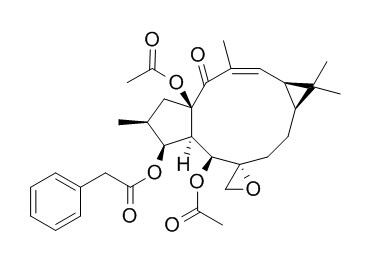Euphorbiasteroid
Euphorbiasteroid has anti-obesity activities, it inhibits adipogenesis of 3T3-L1 cells through activation of the AMPK pathway. Euphorbiasteroid could be a transport substrate for P-gp that can effectively inhibit P-gp-mediated drug transport and reverse resistance to anticancer drugs in MES-SA/Dx5 cells; it induces HL-60 cells to apoptosis via promoting Bcl-2/Bax apoptotic signaling pathway in a dose-dependent manner.
Inquire / Order:
manager@chemfaces.com
Technical Inquiries:
service@chemfaces.com
Tel:
+86-27-84237783
Fax:
+86-27-84254680
Address:
1 Building, No. 83, CheCheng Rd., Wuhan Economic and Technological Development Zone, Wuhan, Hubei 430056, PRC
Providing storage is as stated on the product vial and the vial is kept tightly sealed, the product can be stored for up to
24 months(2-8C).
Wherever possible, you should prepare and use solutions on the same day. However, if you need to make up stock solutions in advance, we recommend that you store the solution as aliquots in tightly sealed vials at -20C. Generally, these will be useable for up to two weeks. Before use, and prior to opening the vial we recommend that you allow your product to equilibrate to room temperature for at least 1 hour.
Need more advice on solubility, usage and handling? Please email to: service@chemfaces.com
The packaging of the product may have turned upside down during transportation, resulting in the natural compounds adhering to the neck or cap of the vial. take the vial out of its packaging and gently shake to let the compounds fall to the bottom of the vial. for liquid products, centrifuge at 200-500 RPM to gather the liquid at the bottom of the vial. try to avoid loss or contamination during handling.
Enzyme Microb Technol.2022, 153:109941.
Processes2022, 10(10), 2008.
Food Hydrocolloids2024, 57:110432
J Biochem.2024, 175(3):253-263.
Phytochem Anal.2013, 24(5):493-503
Front Microbiol.2019, 10:2806
BMC Cancer. 2021, 21(1):91.
Industrial Crops and Products2022, 188:115596.
Kaohsiung J Med Sci.2023, 10.1002/kjm2.12764
Pharmaceuticals (Basel).2024, 17(3):341.
Related and Featured Products
Cell Biochem Funct. 2015 Jun;33(4):220-5.
Euphorbiasteroid, a component of Euphorbia lathyris L., inhibits adipogenesis of 3T3-L1 cells via activation of AMP-activated protein kinase.[Pubmed:
25914364]
The purpose of this study is to investigate the effects of Euphorbiasteroid, a component of Euphorbia lathyris L., on adipogenesis of 3T3-L1 pre-adipocytes and its underlying mechanisms.
METHODS AND RESULTS:
Euphorbiasteroid decreased differentiation of 3T3-L1 cells via reduction of intracellular triglyceride (TG) accumulation at concentrations of 25 and 50 μM. In addition, Euphorbiasteroid altered the key regulator proteins of adipogenesis in the early stage of adipocyte differentiation by increasing the phosphorylation of AMP-activated protein kinase (AMPK) and acetyl-CoA carboxylase. Subsequently, levels of adipogenic proteins, including fatty acid synthase, peroxisome proliferator-activated receptor-γ and CCAAT/enhancer-binding protein α, were decreased by Euphorbiasteroid treatment at the late stage of adipocyte differentiation. The anti-adipogenic effect of Euphorbiasteroid may be derived from inhibition of early stage of adipocyte differentiation.
CONCLUSIONS:
Taken together, Euphorbiasteroid inhibits adipogenesis of 3T3-L1 cells through activation of the AMPK pathway. Therefore, Euphorbiasteroid and its source plant, E. lathyris L., could possibly be one of the fascinating anti-obesity agent.
Phytother Res. 2010 Jul;24(7):1042-6.
Euphorbiasteroid reverses P-glycoprotein-mediated multi-drug resistance in human sarcoma cell line MES-SA/Dx5.[Pubmed:
19960428 ]
METHODS AND RESULTS:
In this study, we evaluated whether Euphorbiasteroid isolated from Euphorbia lathyris has the potential to reverse P-glycoprotein (P-gp)-mediated multi-drug resistance (MDR) by using the drug-sensitive human sarcoma cell line MES-SA and its MDR counterpart MES-SA/Dx5. Interestingly, even at low concentrations of Euphorbiasteroid (1-3 microM), it efficiently restored the toxicities of anticancer drugs including vinblastine, taxol and doxorubicin in MES-SA/Dx5 cells. Additionally, the computational Bayesian model for predicting potential P-gp substrates or inhibitors revealed that Euphorbiasteroid showed 97% probability for substrate likeness having similar molecular features with 50 P-gp substrates. Consistent with this result, the substrate likeness of Euphorbiasteroid was also experimentally confirmed by P-gp ATPase activity assay.
CONCLUSIONS:
In conclusion, our finding suggested that Euphorbiasteroid could be a transport substrate for P-gp that can effectively inhibit P-gp-mediated drug transport and reverse resistance to anticancer drugs in MES-SA/Dx5 cells.
Chinese Journal of Cancer Prevention & Treatment, 2014 , 21 (23) :1865-1870.
Mechanism of euphorbiasteroid inducing apoptosis of HL-60 cells[Reference:
WebLink]
To investigate the effect of Euphorbiasteroid on inducing the apoptosis of HL-60 cells and identify the role of Bcl-2/Bax signaling pathway in this process.
METHODS AND RESULTS:
HL-60 cells were treated with low, middleand high dose of Euphorbiasteroid in vitro for 24 h and after that cell counting Kit-8 was used to detect cell proliferation. The morphology of HL-60 cells was observed under light and fluorescent microscopy. The early cell apoptosis was detected using flow cytometry with Annexin V/PI double staining. The expressions of Bcl-2, Bax, Caspase-9, Caspase-3 mRNA were analyzed by RT-PCR. The activity of Caspase-9, 3 was examined by chromatometry, ELISA detect Caspase-9, Caspase-3 activity of protein. HL-60 cell proliferation was inhibited significantly by Euphorbiasteroid administration (F=42.97, P<0.001). Comparison between different concentrations, the difference was statistically significant, P<0.05. Early cell apoptosis rate of HL-60 cells was enhanced markedly after Euphorbiasteroid administration (F=56.74, P<0.001), after 10, 20, 40 μg/mL Euphorbiasteroid treatment for 24 h, the HL-60 cells early apoptosis rate respectively were(23.4±3.1)%, (35.7±4.3)%, (53.2±3.9)%, and cells presented typical apoptosis morphological changes. Bax mRNA transcription level increased significantly, the Bcl-2 mRNA transcription level decreased significantly (F=53.45, P<0.001) after Euphorbiasteroid administration in a dose-dependent manner. Caspase-9, Caspase-3 mRNA were up-regulated in the transcriptional level, and a compound dose dependent (F=34.21, P<0.001), semen euphorbiae sterol effect on the HL-60 cells after 24 h Caspase-9, 3 protein activity significantly increased (F=54.33, P<0.001), with the increase of concentration of semen euphorbiae sterol the protein activity increased.
CONCLUSIONS:
Euphorbiasteroid induces HL-60 cells to apoptosis via promoting Bcl-2/Bax apoptotic signaling pathway in a dose-dependent manner.



